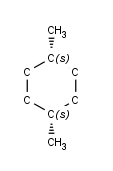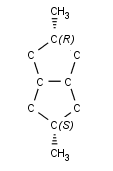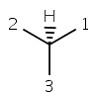Parity
Introduction
Parity is a general type of specification of chirality. The two most commonly used types, tetrahedral parity and allene-like parity, is implemented. Square-planar, trigonal-bipyramidal, and octahedral parity classes are not yet supported.
Tetrahedral Parity
Global Parity
Criteria for having nonzero parity value
-
Tetrahedral central atom has parity, if
-
4 different types of ligands around the central atom.
-
Implicit Hydrogen atoms and lone pairs also considered as ligands, and
-
implicit and explicit hydrogen does not count as different kinds of ligands.
-
-
If not all 4 ligands are different, the atom can have global parity, if the ligands have different stereo environment.



-
-
Atoms N, P and S in ring have parity, if
-
they are bridgehead atoms.

-
-
N has parity in a 3 membered ring,
-
if the graph invariant of the ring is not the same in the two sides of the nitrogen atom.
-
-
Sulfur atom can have a lone electron pair to allow chiral sulfoxides.
Determination of the value of the global parity
-
Number the atoms around the stereocenter according to the position in the atom block.
-
Hydrogen gets the highest value, in this case 4.
-
View the molecule such, that the atom that has the highest number is behind the plane formed by the other three atoms.
-
Now, the three atoms forming the plane may arrange
-
either clockwise, in which case the general parity of the stereo center is called ODD,
-
or counterclockwise, in which case the general parity of the stereo center is called EVEN.


parity ODD
parity EVEN
-
Note that it is not possible to change parity value from 0 to PARITY_EITHER and vice versa without changing atoms in the molecule.
Possible global parity values
|
0 |
For atoms which cannot have tetrahedral parity. |
|
ODD |
For atoms which have ODD parity. |
|
EVEN |
For atoms which have EVEN parity. |
|
PARITY_EITHER |
For atoms which can have parity but it is unspecified. |
Local Parity
An atom have nonzero local parity, if
-
number of implicit and explicit H < 3,
-
number of implicit H < 2.
The determination of he local parity is similar to that of global parity:
-
Number the atoms around the stereocenter according to the atom number (position in the atom block).
-
Hydrogen atoms get the highest values: a constant number is added to the atom number of all the H atoms.
-
View the molecule such, that the atom that has the highest number is behind the plane formed by the other three atoms.
-
Now, the three atoms forming the plane may arrange
-
either clockwise, in which case the local parity of the stereo center is called ODD,
-
or counterclockwise, in which case the local parity of the stereo center is called EVEN.
-
For example, the molecule depicted below has non-zero local but zero global parity value:

Allene-like Parity
An atom can have allene-like parity if the following condition holds:
-
there are equal numbers of double bonds in each side of the central atom,
-
there are at least two different ligands on both terminal atoms.
In connection with allene-like parity
local
and
global
types are not differentiated.
Allene like parity is defined as follows.
-
Number the two pairs of atoms which connect to the central atom through one single and odd number of double bond with 1, 2, 3 and 4 in order of increasing atom number (position in the atom block).
-
Hydrogen atom should be the highest numbered atom, in this case atom 4.
-
If the molecule contains two hydrogen atoms, then that one gets the smaller value (3), which is on the same side of the central atom as the ligand with higher atom number.
-
View the molecule such, that the atom that has the highest number is behind the plane formed by the other three atoms.
-
Now, the three atoms forming the plane may arrange
-
either clockwise, in which case the parity of the stereo center has the value 1,
-
or counterclockwise, in which case the parity of the stereo center has the value 2.
-